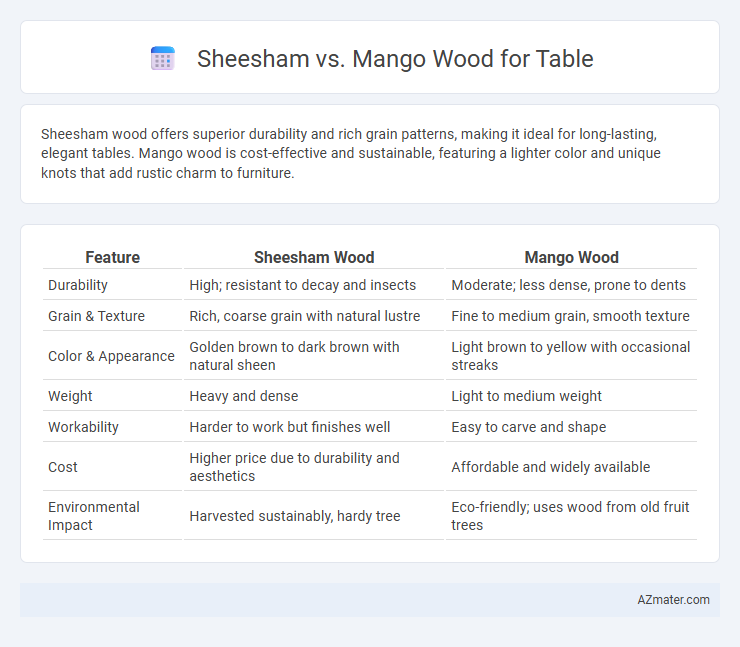Sheesham wood offers superior durability and rich grain patterns, making it ideal for long-lasting, elegant tables. Mango wood is cost-effective and sustainable, featuring a lighter color and unique knots that add rustic charm to furniture.
Table of Comparison
| Feature | Sheesham Wood | Mango Wood |
|---|---|---|
| Durability | High; resistant to decay and insects | Moderate; less dense, prone to dents |
| Grain & Texture | Rich, coarse grain with natural lustre | Fine to medium grain, smooth texture |
| Color & Appearance | Golden brown to dark brown with natural sheen | Light brown to yellow with occasional streaks |
| Weight | Heavy and dense | Light to medium weight |
| Workability | Harder to work but finishes well | Easy to carve and shape |
| Cost | Higher price due to durability and aesthetics | Affordable and widely available |
| Environmental Impact | Harvested sustainably, hardy tree | Eco-friendly; uses wood from old fruit trees |
Introduction to Sheesham and Mango Wood
Sheesham wood, also known as Indian Rosewood, is prized for its durability, rich, dark brown hues, and intricate grain patterns, making it a popular choice for high-quality furniture like tables. Mango wood offers a sustainable alternative, characterized by a lighter, yellowish-brown color with subtle grain, harvested from the mango fruit trees after their fruit-bearing life ends. Both woods provide unique aesthetics and strength, with Sheesham often favored for its classic elegance and Mango wood valued for its eco-friendly sourcing and affordability.
Origin and Availability of Sheesham vs Mango Wood
Sheesham wood, also known as Indian Rosewood, originates primarily from the Indian subcontinent, particularly in northern India and Pakistan, where it thrives in dry regions and is sustainably harvested. Mango wood comes mainly from South and Southeast Asia, especially India and the Philippines, derived from mango trees once they stop bearing fruit, making it a byproduct with abundant availability. The availability of Sheesham is more controlled due to conservation efforts, while Mango wood's supply is generally more plentiful and economical because it utilizes recycled timber from fruit plantations.
Physical Appearance and Aesthetics
Sheesham wood, also known as Indian rosewood, boasts rich, dark brown hues with distinctive grain patterns and natural streaks that give tables a luxurious and antique appeal. Mango wood features a lighter, golden-brown color with more uniform grain, often accented by occasional knots, creating a rustic and contemporary aesthetic. The contrast in Sheesham's dense, polished finish versus Mango wood's softer texture offers diverse visual and tactile experiences for table design.
Durability and Strength Comparison
Sheesham wood, known for its dense grain and natural oils, offers superior durability and resistance to wear, making it highly suitable for long-lasting tables. Mango wood, while moderately strong and eco-friendly due to its sustainable harvesting, tends to be softer and more prone to scratches compared to Sheesham. In terms of strength, Sheesham wood outperforms Mango by providing better load-bearing capacity and resistance to warping over time.
Workability and Craftsmanship
Sheesham wood offers exceptional workability with its fine grain and natural oils, enabling smooth carving and lasting polish, which makes it ideal for intricate craftsmanship in tables. Mango wood, while harder and heavier, responds well to tools and provides a sturdy surface but may require more effort in detailing compared to Sheesham. Both woods support durable furniture construction, yet Sheesham is generally preferred for artisan-level finish due to its balanced texture and ease of shaping.
Resistance to Termites and Decay
Sheesham wood offers excellent resistance to termites and decay due to its dense grain and natural oils that act as preservatives, making it a durable choice for tables in humid environments. Mango wood, while attractive and sustainably sourced, has moderate resistance and requires proper finishing to protect against termite attacks and moisture damage. For long-lasting termite and decay resistance in table construction, Sheesham wood generally provides superior durability compared to Mango wood.
Environmental Impact and Sustainability
Sheesham wood, sourced from Dalbergia trees, is known for its durability but faces concerns due to overharvesting and limited reforestation efforts, impacting biodiversity. Mango wood, derived from discarded mango trees after fruit production declines, is a more sustainable option that utilizes waste wood and reduces deforestation pressure. Choosing mango wood for tables supports eco-friendly practices by promoting wood recycling and minimizing carbon footprint compared to Sheesham wood, which is less renewable and more susceptible to illegal logging.
Maintenance and Care Requirements
Sheesham wood tables require regular oiling to maintain their rich grain and prevent drying or cracking, while mango wood tables benefit from occasional waxing to preserve their smooth finish and resist moisture damage. Both woods should be cleaned with a soft, damp cloth and avoid harsh chemicals to protect their surfaces. Proper maintenance extends the lifespan of each wood type, with Sheesham demanding slightly more frequent care due to its denser grain structure.
Price and Value for Money
Sheesham wood tables generally offer higher durability and rich grain patterns at a moderate to premium price point, making them a valuable investment for long-term use. Mango wood tables are typically more affordable, combining decent strength with sustainable sourcing, which enhances their appeal for budget-conscious buyers seeking good value. While Sheesham excels in longevity and aesthetic appeal, Mango wood provides a cost-effective option without compromising basic functionality.
Which Wood is Best for Your Table?
Sheesham wood offers exceptional durability and rich grain patterns, making it ideal for long-lasting, elegant tables, while mango wood is more affordable and eco-friendly with a lighter, smoother finish. For high-traffic areas or heirloom-quality furniture, Sheesham's density and resistance to termites provide superior strength. Mango wood suits budget-conscious buyers seeking sustainable options and a warm, rustic aesthetic for casual or decorative tables.

Infographic: Sheesham vs Mango Wood for Table
 azmater.com
azmater.com